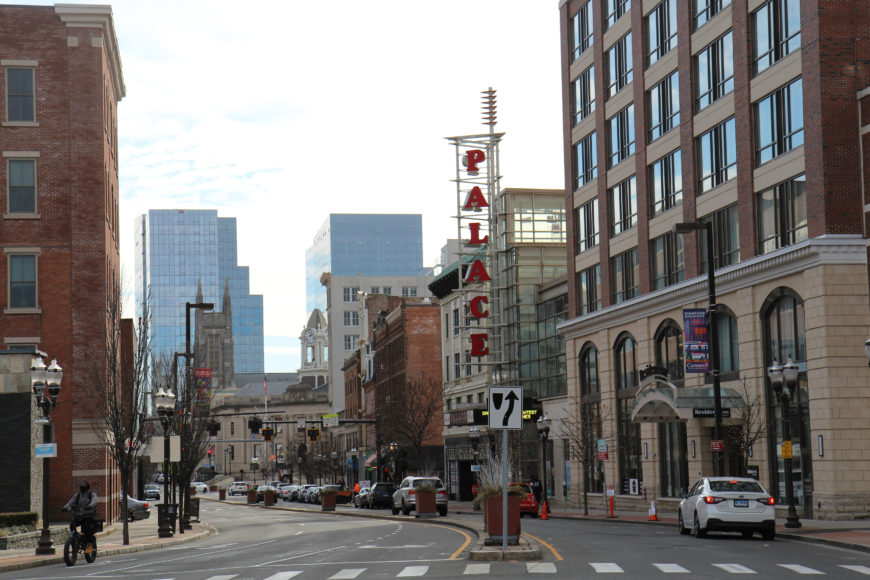For two weeks in February, Stamford stood at the center of the sporting universe — and indeed, the geopolitical one — as NBC Sports carried the controversial Beijing Winter Olympics over 2,800 hours using more than 1,500 employees — mainly from its headquarters in the city. It’s a symbol of how important Stamford has become to the region — and why we chose it for our second salute to a municipality in our coverage area, fresh off the success of our December Yonkers tribute.
The second-largest city in Connecticut after Bridgeport with a population of 135,470, Stamford is also the second-biggest financial district in the metro area after You Know What. Its superb coastal location between New York City and New Haven has made it a source of maritime commerce since its founding in 1641. And numerous Fortune 500 companies and corporate divisions have driven it to become a Manhattan mini me in other ways, with thriving residential and commercial real estate development led by such enterprises as Building and Land Technology (Jeremy’s story) and WellBuilt Co. (Phil’s story), a bustling “Restaurant Row” (Jeremy again) and a blooming, post-pandemic media and entertainment scene. (See our story on Stamford arts.)
No one better embodies this excitement than recently elected Mayor Caroline Simmons, the first woman to hold the post in the city’s surprisingly colorful history. As Justin McGown of our sister publication the Fairfield County Business Journal discovered (welcome, Justin), Simmons is not one to shrink from running a city while being the hands-on mother of two toddlers and a newborn (bless her). No, she’s plunged right in, relishing the connection she feels with working moms — and the rest of her constituents — throughout the city.
She’s not the only one looking out for entrepreneurial women like broker Libby Matson — a woman with her finger on the pulse of a city whose desirable real estate has created challenges in the area of supply and demand. Simmons once worked for the 25-year-old Women’s Business Development Council (WBDC), founded in Stamford by Fran Pastore, who tells us that despite the economic havoc wreaked by Covid-19, “there is no area of business that women are not moving into.”
And men right along with them. From Mike’s Organic to The Lloyd Stamford, part of Hilton’s boutique Tapestry Collection (Jeremy’s pieces), Stamford is a city that works hard, as Peter discovered in profiling the leadership of its Board of Representatives, which functions as a city council. But Stamford plays hard, too. There are great places not only to dine in and savor culture but to shop for home goods and design (Cami’s column). Like Manhattan, Stamford is a repository of fabulous mid-century Modern architecture, including the piscine First Presbyterian Church, known as the Fish Church (Katie’s column). No wonder seniors (Abbe’s column) and celebrities alike enjoy calling the city home. (See our article on celebrated Stamford.)
Like all cities, it has had its flaws. It is, after all, located along that modern-day Gordian knot known as I-95. Its history has had its share of would-be witches, potential pirates (well, certainly privateers) and even Ku Klux Klansmen. Yet Stamford would transcend the baser impulses of democracy as you’ll see in our story “The Stamford Nobody Knows.”
Few people exemplified this transcendence more than Stamford scion Abraham Davenport, who on Connecticut’s literally darkest day, called for the calm to carry on; and Homer Stillé Cummings, a former Stamford mayor and prosecutor who could’ve satisfied the bloodthirst for vengeance and sent an innocent man to his death but instead held out for justice — and became “his brother’s keeper.”
This was the city that gave Jackie Robinson — the man who broke baseball’s color barrier in 1947 — a home when other municipalities in Fairfield and Westchester counties closed their doors.
What can we say about Stamford? Not that it’s never known the dark recesses of the human soul but that in moments of such darkness, it ultimately has chosen to shine a light.
A 2020 YWCA White Plains & Central Westchester Visionary Award winner and a 2018 Folio Women in Media Award Winner, Georgette Gouveia is the author of “Burying the Dead,” “Daimon: A Novel of Alexander the Great” and “Seamless Sky” (JMS Books), as well as “The Penalty for Holding,” a 2018 Lambda Literary Award finalist (JMS Books), and “Water Music” (Greenleaf Book Group). They’re part of her series of novels, “The Games Men Play,” also the name of the sports/culture blog she writes.
Last year, her short story “The Glass Door” was published by JMS and exhibited in “Together apART: Creating During COVID” at ArtsWestchester in White Plains. Her latest story, “After Hopper,” is also available from JMS Books. For more, visit thegamesmenplay.com.





